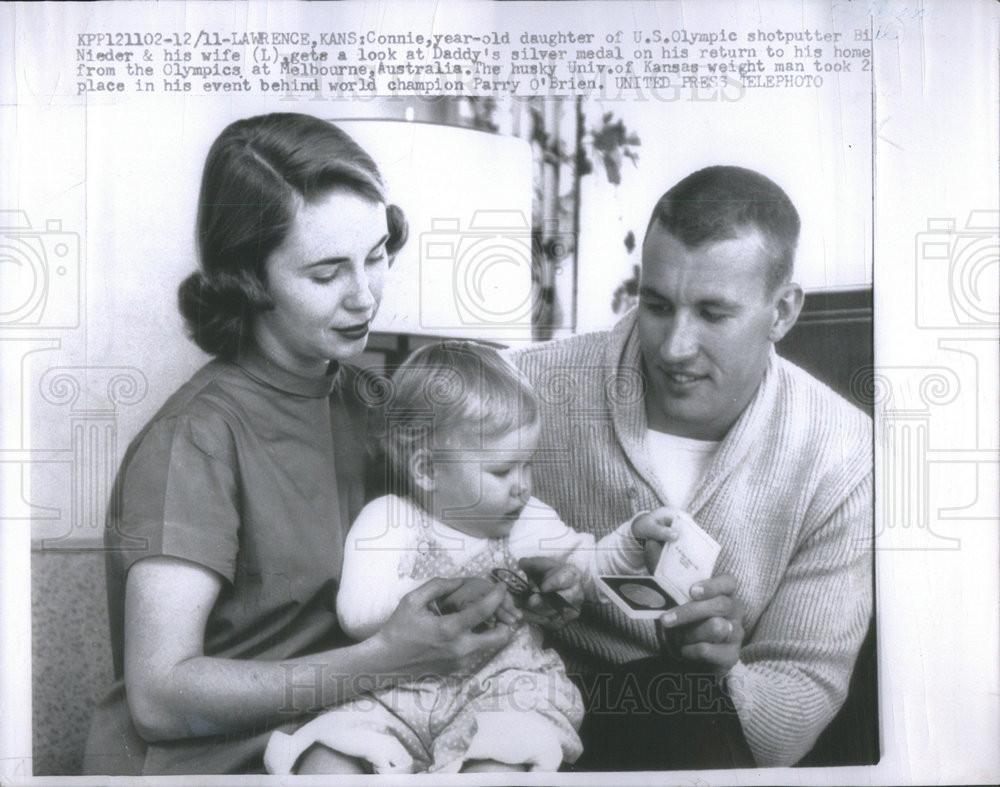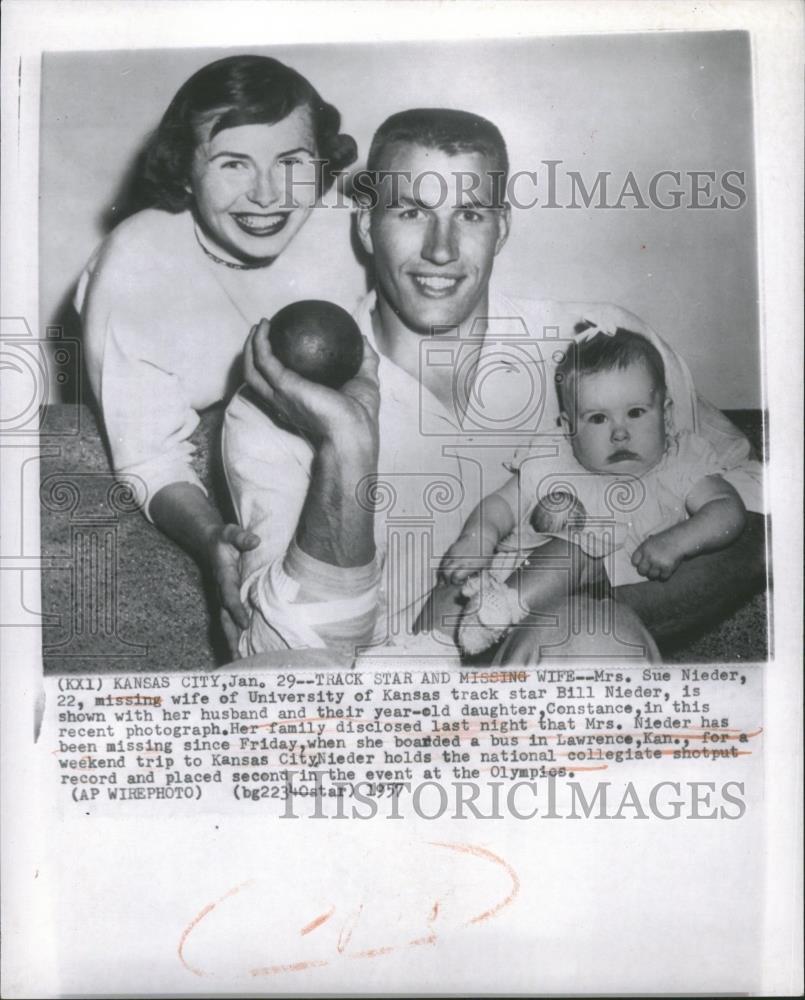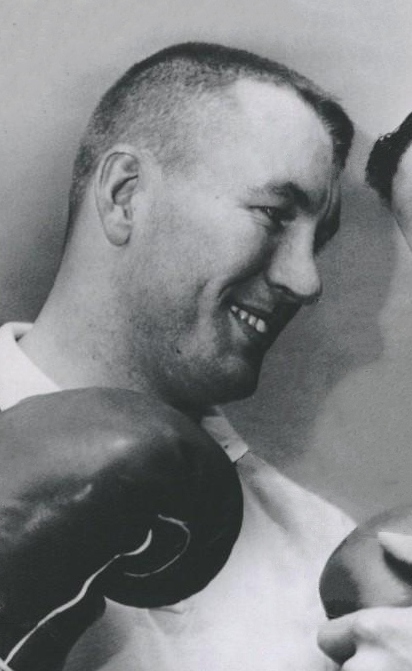1. Life and background
Bill Nieder's early life was rooted in the eastern United States before his family relocated to Kansas, where he spent his formative years and pursued his education, laying the groundwork for his future athletic and professional endeavors.
1.1. Birth and upbringing
William Henry Nieder was born on August 10, 1933, in Hempstead, New York, a village located in Nassau County on Long Island. He later grew up in Lawrence, Kansas. During his athletic career, he was married to Sue and had a daughter named Connie, who was approximately one year old at the time of the 1956 Melbourne Olympics. Nieder stood 75 in (190 cm) tall and weighed 225 lb (102 kg).


1.2. Education
Nieder attended the University of Kansas, where he distinguished himself as a student-athlete. He achieved a significant milestone in collegiate athletics by becoming the first university athlete to throw a 16 lb (16 lb) shot put beyond the 60 ft mark. Prior to his collegiate success, he had already made history in high school, being the first prep athlete to break the 60 ft barrier with a 12 lb (12 lb) shot put.
2. Athletic career
Bill Nieder's athletic career was marked by his exceptional prowess in shot put, where he achieved Olympic success and set multiple world records, despite facing formidable rivals. His journey into track and field was influenced by an early injury, leading him to focus on the throwing events.
2.1. Early career and transition
Nieder began his career in athletics after sustaining a significant injury during his time playing American football. At the age of 19, he suffered a severe left knee injury that required 44 stitches, which prompted his transition to track and field. He subsequently dedicated himself to the shot put, rapidly improving his skills. By 1955, he was capable of throwing 58 ft (17.66 m).
2.2. Major competitions and achievements
Throughout his career, Nieder competed against strong rivals such as Parry O'Brien and Dallas Long. Despite their presence, Nieder consistently performed at an elite level, securing Olympic medals and establishing himself as a world record holder. He won national championships only twice during his prime.
2.2.1. Olympic medals
Nieder competed in two consecutive Olympic Games, earning medals in both appearances.
- At the 1956 Melbourne Olympics, he won a silver medal in the shot put with a throw of 60 ft (18.18 m), finishing behind his rival Parry O'Brien.
- Four years later, for the 1960 Rome Olympics, Nieder initially placed fourth at the U.S. Olympic Trials due to a hand injury, which meant he did not secure an automatic spot on the national team. However, he was later selected after fellow athlete Dave Davis withdrew due to an injury. At the Rome Olympics, Nieder delivered a gold medal-winning performance with a throw of 65 ft (19.68 m). This mark set a new Olympic record and represented a significant improvement of 5 ft from his performance in Melbourne four years prior. Although Parry O'Brien had also improved, Nieder's throw was nearly 2 ft further than O'Brien's.
2.2.2. World records and other achievements
Bill Nieder set the shot put world record on three separate occasions, pushing the boundaries of the sport.
- In March 1960, he first broke Dallas Long's record with a throw of 64 ft (19.45 m).
- Just one week later, Long reclaimed the world record.
- However, Nieder responded by setting a new world record of 66 ft (19.99 m) a week after that, nearing the 66 ft (20 m) milestone.
- On August 12, 1960, shortly before the Rome Olympics, Nieder achieved a historic feat by becoming the first human to throw the shot put over 66 ft (20 m), setting a new world record of 66 ft (20.06 m). This momentum carried him to his Olympic gold medal.
His collegiate and high school achievements also stand out, as he was the first collegiate athlete to surpass the 60 ft mark with a 16 lb (16 lb) shot and the first high school prep athlete to break the 60 ft barrier with a 12 lb (12 lb) shot put.
2.3. Events
Bill Nieder primarily competed in the shot put, which was the event in which he achieved his Olympic medals and world records. He also competed in the discus throw. His personal bests were 66 ft (20.06 m) in shot put (1960) and 150 ft (45.72 m) in discus throw (1955).

3. Post-career activities
After concluding his distinguished athletic career, Bill Nieder explored new professional avenues, including a brief foray into boxing and a significant tenure at 3M, where his contributions had a lasting impact on the field of athletics.
3.1. Boxing attempt
Following the 1960 Rome Olympics, Bill Nieder ended his track and field career and transitioned to professional boxing. However, his boxing career was short-lived; he was knocked out in the first round of his debut professional bout by a regular boxer. After this experience, he decided to retire from boxing permanently. Although he later attempted to return to athletics, he was unable to regain his previous form and strength.
3.2. Career at 3M
Nieder was employed by the diversified technology company 3M as a salesman, a role he held for ten years. Leveraging his status as an Olympic medalist and his persuasive abilities, he played a crucial role in the development and marketing of synthetic track surfaces. He was instrumental in selling the first-ever synthetic track surface, known as Tartan track, for an Olympic Games to the organizers of the 1968 Mexico City Olympics. These synthetic tracks have since become the standard for all major track and field competitions worldwide. Utilizing proprietary formulas from 3M, Nieder also developed an improved version of the "rubber room," a specialized padded surface, which helped 3M outperform competitors who struggled to meet fire safety standards with their own formulas.
4. Personal incidents and activities
Beyond his athletic and professional endeavors, Bill Nieder was also involved in a notable personal incident where he demonstrated courage and quick thinking as a civilian.
4.1. Aircraft cabin incident
On Sunday, May 8, 2011, while traveling on American Airlines flight 1561 bound for San Francisco, Bill Nieder, then 77 years old, played a part in subduing a passenger who was attempting to breach the cockpit. According to witnesses, Nieder rose from his seat to use the restroom and unknowingly bumped into the disruptive passenger. This accidental encounter allowed the American Airlines flight attendants to intervene and prevent the passenger from entering the cockpit.
5. Honors and awards
Bill Nieder received significant recognition for his contributions to athletics, culminating in his induction into a prestigious hall of fame.
5.1. National Track and Field Hall of Fame
In 2006, Bill Nieder was formally inducted into the National Track and Field Hall of Fame, acknowledging his outstanding achievements and lasting impact on the sport of track and field.
6. Death
Bill Nieder passed away on October 7, 2022, at the age of 89. His death was announced by the University of Kansas, his alma mater, in the week following his passing. He died in Angels Camp, California.
7. Assessment and impact
Bill Nieder's legacy in athletics is defined by his groundbreaking achievements in the shot put, particularly his pioneering efforts in breaking the 60 ft and 66 ft (20 m) barriers, which significantly advanced the sport. His Olympic gold and silver medals underscore his competitive excellence. Beyond his athletic prowess, his post-career work at 3M, especially his role in popularizing synthetic track surfaces, had a profound and lasting impact on the infrastructure of track and field, making it safer and more consistent for athletes globally. His actions as a civilian, such as assisting in the aircraft incident, further highlight his character and willingness to act in critical situations.